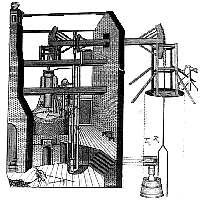Thomas Newcomen
- 1663 - 1729 -


The Newcomen engine was successful.
Newcomen made his efficient engine after ten years of experiments. However, due to the patent accorded to Savery for each engine based on fire, Newcomen's opportunities to develop his engine were limited. Newcomen had to establish a firm with Savery. The Newcomen atmospheric engine (please see the animation) had a piston connected to a large crossbeam. The other end of the crossbeam was connected to a very heavy pump piston. In 1725, the Newcomen engine was employed in many coal mines but also was used to take water to mill-wheels.
This engine was slow and wasteful.
Each injection of water chilled the cylinder and the steam was consumed in reheating the cylinder for the next stroke. The thermal efficiency of this engine was about 1% ie for every 100 kg of coal burned, only 1 kg was utilized to pump water! Notwithstanding this very grave deficiency, the Newcomen engine worked without rivals for a long time (60 years) and also out of Britain.
The salient feature of this engine is that it worked with low steam pressure (one atmosphere), which was dictated by the level of technology at the time.
The crossbeam vibrated 12 times/minute and for each stroke, the pump piston sucked 45 litres of water which was then pushed to reach a height of 46 metres. The power of this first engine was about 5.5 HP. The rise of the engine piston was caused by the descent of the heavy pump piston. The steam, from the boiler, was put into the cylinder. Next, cold water was sprayed into the cylinder, thereby condensing the steam. This created a partial vacuum and atmospheric pressure drove the piston down (active stroke). On this stroke, the crossbeam pulled up the pump piston which raised water from the coal mine.
The steam was produced by a little boiler at atmospheric pressure.
The condensed water went out through an exhaust valve which had a sluice gate.
The time spent in cooling and reheating made the engine too slow for use as anything other than a pump.
Newcomen was not able to exploit his engine because Savery, and after him, others, held the patent for any engine based on fire.